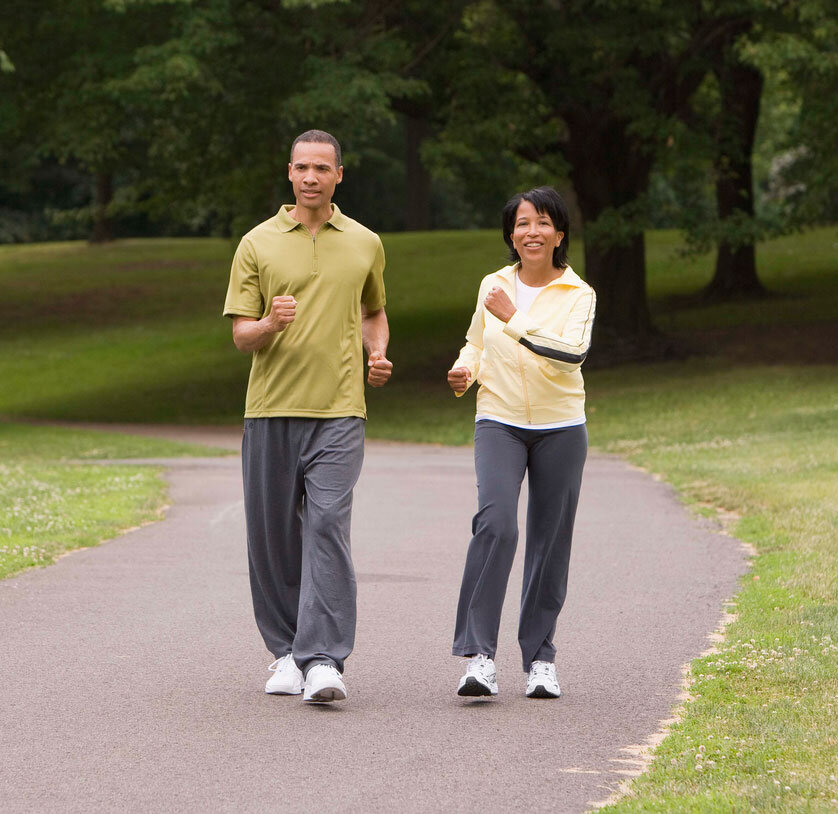Am I Burning Fat or Carbs When I Exercise?
The source of your body’s fuel is largely determined by the intensity of your exercise. Fat is an energy source that cannot be broken down quickly and used by the body. So if a lion jumps out of the bush and you start sprinting in fear, you will not be burning fat. Energy needed for the quick bursts comes from carbs. Also energy needed for higher intensity exercise comes largely, but not entirely, from carbs.
If you simply browse the headers of this article, you will miss the boat!
It is important that you read the explanations that go along with the headers, because there is much more to the eye. If you read this entirely, you will be empowered with the knowledge to make the best decisions regarding your fitness goals and your schedule. Trust me on this one.
Walking burns mostly fat.
Low-intensity exercise such as walking, burns both fat and carbs, but mostly fat. There is a problem though. Low-intensity exercise does not burn a bunch of calories. Walking is a weight bearing exercise, so the more you weigh, the more calories you burn. It takes more calories to move 300 pounds a mile, than it does to move 160 pounds. These people pictured may have to walk over 14 hours to burn one pound of fat!
With that said, based on your fitness goals and the amount of time you have to dedicate to exercise, would walking be your best choice? For the elderly or those considerably overweight, walking can be a higher intensity form of exercise and burn considerable calories. But your body, and weight loss, can plateau as you lose weight, or if you were not obese to begin with. Let’s face it, you have been walking since you were a toddler and the human body has become very efficient at it.
Jogging burns mostly carbs.
Jogging burns both fat and carbs, but mostly carbs. If you look at the amount of calories burned in a hour while jogging, it will be considerably higher than walking. It can easily be 3X more calories. For that reason, higher intensity exercise, like jogging, can be a better choice for creating a calorie deficit. A calorie deficit is the goal if you are trying to lose weight!
I have used walking and jogging in the examples above, but this is more accurately called lower and higher intensity exercise. You can be on a stationary bike peddling casually and burn most fat but little overall calories. Or you can be on the same bike and busting your butt, burning more carbs than fat, but many more overall calories. So intensity, and not the particular exercise of choice, that determines which energy source your body turns to.
To understand this better, think of a hybrid car that uses a combination of power from batteries and gasoline. At a higher speed, the car uses much more gasoline (carbs) in addition to battery power (fat), and the overall miles driven is much greater. At a lower speed, most of the power used is from the batteries (fat) but the total miles driven are far less. If you want to lose weight, I feel you should be more concerned about the total miles driven (total calories burned), unless you have considerable time on your hands to exercise at a lower intensity.
So you have learned that the source of your body’s fuel is largely determined by the intensity of your exercise. Many people are not performing their cardiovascular exercise at the proper intensity, especially if their goal is weight loss. If your goal is weight loss, you should choose higher intensity exercise. It can take you month to lose a pound with lower intensity exercise, or a week with higher. The main goal with weight loss is to create a calorie deficit.
What about weight lifting?
Strength training can have a tremendous benefit to the number of calories you burn each day. Not so much from the calories burned during the actual workout, but from the incredible boost to your metabolism by adding muscle tone.
Your metabolism will always burn more calories every day than any workout.
If you want to burn calories right here and right now, choose cardiovascular exercise mentioned above. If you want to burn more calories in the long haul, nothing beats strength training.
Obviously, a combination of both strength training and cardio will give you the most control of your weight for a lifetime.
What is the best exercise choice for me?
There are a few factors here to consider.
Safety.
If you are considerably overweight, it would not be safe to jump right into a running program. The risk of getting shin splints or other overuse injury does not outweigh the benefits. If you are overweight, walking in itself can be a higher intensity exercise by itself. As you lose weight this will become lower and lower in intensity, and then you should consider picking up the pace, or increasing the length of your workouts.
If you are elderly, jogging or riding a bike on the streets may not be the safest choice. You need to respect your abilities and comfort level, and make an educated choice. At any age, I always recommend starting slow and increasing the challenge over time. I have seen plenty of people in the 30s jump on a bike for the first time in 8 years and start racing down the bike trail, only to crash because they were a bit rusty.
Weight bearing vs. non-weight bearing.
As explained earlier, if you weigh 300 pounds, walking one mile can be a high intensity exercise. This goes for any weight bearing exercise! The more you weigh, the harder it will feel. For that reason, if your fitness level is low and you want to exercise for 30 minutes, consider a non-weight bearing exercise. A stationary bike, or a rower are two good examples. If you are not weight bearing, everyone burns the same number of calories, no matter what the scale says.
Non-weight bearing exercise is also easier on the joints. If you have a bad back, hips, knees, etc., consider easing the load on these joints with non-weight bearing exercise. If you are an avid runner, have you considered how your knees are going to be in 15 years? Many people fail to look into the future and consider the toll that is being taken on the body. Maybe the avid runner can run 1-2X per week and then ride a bike for the same. Doing this just cut down the pounding on your joints by half. This advice does adversely affet the job security for orthopedic surgeons!
Time.
We’ve covered this one pretty well already. Do you have a fitness or weight goal that has to be reached by a certain date? This can influence your decision on exercise intensity.
Benefits to heart and lungs.
If your goal for exercise is to improve the health and function of your cardiovascular system, higher intensity exercise is better. This is what stimulates physiological changes in your body, as well as physical changes.
Heart rate determines intensity.
If you want an accurate determination of intensity, you should go by your heart rate. There are many apps on your phone that can determine your exercising heart rate, or you can invest in a heart rate monitor.
You can also use a “rating of perceived exertion” chart. Although not as accurate, they can be very effective.
The best formula to determine your target heart rate is the Karvonen method, and uses your resting heart rate to determine your target heart rate during exercise. This method is acceptable if you are on beta blockers for high blood pressure.
The average resting heart rate for an adult is 72 beats per minute (to find your resting heart rate, take your pulse for one minute before you get out of bed) and I will use that in the following example.
Here is a calculation for a 42 year old with a resting heart rate of 72 beats per minute, wanting to exercise at 70% intensity:
220, less your age, less your resting heart rate, multiplied by your intensity percentage, plus your resting heart rate. Here is what is looks like: 220 – 42 (age) – 72 (resting heart rate) X 70% + 72 (resting heart rate) = 146 beats per minute. As you can see, the heart rate was underestimated by 20 beats per minute with the more commonly used formula.
Proper intensity levels based on target heart rate:
Low intensity: 50-60%
Moderate: 60-70%
High: 70-85%
Conclusion.
Back to the topic at hand…am I burning fat or carbs when I exercise? You are always burning a combination of fat and carbs. It boils down to the percentage of fat vs. carbs at any given level of intensity. It does not matter what your “exercise of choice” is. So try to find something that you might enjoy, or at least tolerate, and go!




